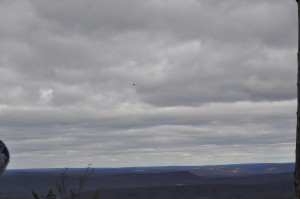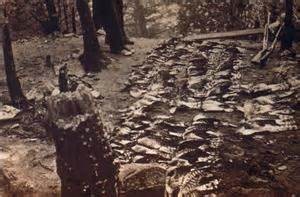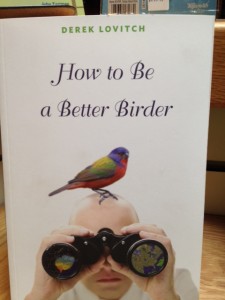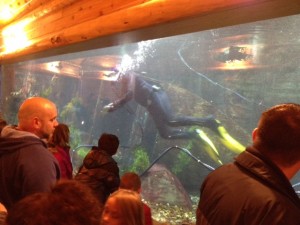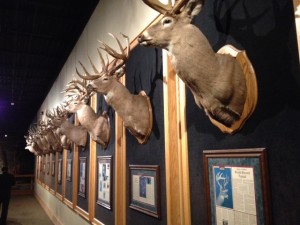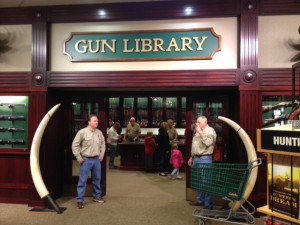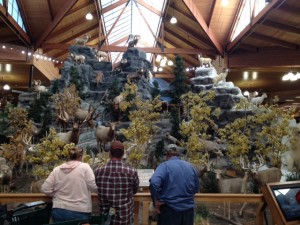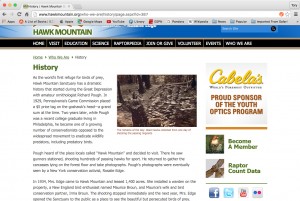On Saturday morning I sat on the windy ridge, listening to the Hawk Mountain biologist, surrounded by other bird watchers, all craning our necks every which way to see the birds soar overhead. From the 5 year-old girl to the 60-something year old veteran bird counter, we were all being educated on an animal that is far superior than us. This weekend I learned that Hawk Mountain isn’t just a place to go for a hike or a place to escape reality but rather it is a place to get first-hand knowledge. Visiting Hawk Mountain provides an opportunity for us all to learn about birds of prey and why they travel to our little sliver of Pennsylvania. This educational message is clear both in the visitor center displays and up on the quiet ridge. While on the ridge you are surrounded by people that are so passionate about birds that they radiate their passion towards you when you sit amongst them. You want to join in their silence and admiration as you wait to see which species of birds will fly past next. While at the visitor center the displays contain more direct educational material. This includes photo murals of mass hunting expeditions that took place at Hawk Mountains in the early 1900s and statistics on how many birds were shot down there prior to the establishment of the sanctuary. Other educational material includes large hanging displays of the various birds tat can be seen at the sanctuary and light up maps of various migration paths. These displays provide a more detailed insight into the various bird of prey species.
These images differ drastically from how Cabela’s displays nature. Cabela’s displays nature as something that humans should be intervening with and dominating. This is seen in their sales of guns, crossbows, extensive hunting gear, fishing supplies, variety of home décor- oh and their extensive display of taxidermy animals. There are some small signs on how to stop illegal poachers and at times the idea that hunters can be useful in controlling overpopulation is shared but overall, the store is clearly not focused on encouraging their customers to be environmental stewards. There are clear undertones of violence in Cabela’s that the store strategically tries to cover by selling it as an outdoors store that carries tools essential to being in nature, those tools being guns, crossbows and to some- fishing poles. While using nature as a cover up to the larger ideas Cabela’s is trying to sell, the store sends the message that humans should be dominating nature.
It was in the aquarium that I saw an image that summed up my impression that nature takes a back seat to man at Cabela’s. I thought that in the aquarium I would be able to find some escape from the aggressive symbolism of man as conqueror that were seen in the taxidermy displays. But, this was not the case as right before exiting the aquarium Shawn and I happened to look up at the top of the fish tank to find numerous dead and molding fish. Even though Cabela’s sells itself as an outdoors store that encourages people to get out into nature, the store clearly isn’t practicing what it is preaching if they don’t even pay attention to the little amount of “nature” that exists in their own building. Although this was a small moment in my much larger (and horrific) experience at Cabela’s it showed me exactly what Cabela’s intentions were. Unfortunately, the customers that passed through the aquarium were too busy staring at the enormous catfish to notice the disregard Cabela’s has for the nature within its own walls. I guess that catfish was just one more piece of nature that Cabela’s transformed into something to gawk at.
Unlike at Hawk Mountain, visitors are not going to Cabela’s to be educated about the dead animals on the “mountain” but instead are going to gawk and point at them. Through these displays nature comes across as the “other” that we can kill and conquer and has little other values. At Hawk Mountain we learned about birds of prey and how important they are to greater ecosystems. Although there was a focus on birds of prey at Hawk Mountain, it is clear to the visitor that respect should not just be limited to these birds but to nature as a whole. Hawk Mountain acknowledges the interconnectivity of species in ecosystems in the displays they have and in the products they sell. For example, customers can buy accurately designed baby stuffed animals rather than the general stuffed golden retriever puppy at Cabela’s. Hawk Mountain visitors can buy books about habitat conservation and organic snacks that are low impact rather than armed combat DVDs and processed or fried foods that are for sale at Cabela’s.
Hawk Mountain sends an important message that the environment is interconnected. The Center’s information on DDT directly relates to this point and is important to mention when talking about raptor populations. It was because of Hawk Mountain’s consistent population data collection and Rachel Carson’s research on DDT in Silent Spring, that scientists were able to recognize that something was severely wrong with the population and that the two may be connected. Rachel Carson’s work showed that despite our intentions to only kill off one pest in one specific area with DDT this never turned out to be the case. DDT traveled through ecosystems via the natural order of the food chain. DDT built up through the plants, insects and eventually to the smaller animals that predators like the Eagle consume. Since Eagles are at the top of the food chain and are indirectly consuming many parts of the ecosystem, they can indicate whether that ecosystem is healthy. Therefore when the percentage of immature eagles observed at Hawk Mountain dropped from 40% in 1935 to 20% in 1955, it was clear that something was not only wrong with the eagle populations but with the ecosystems that support these predators.
Hawk Mountain is known for its connection to Rachel Carson and the environmental movement which has helped turn it into a tourist destination. That being said, Cabela’s and Hawk Mountain are both destinations for their visitors. However, there is a difference between the two destinations and what the visitors are getting out of their time. As I mentioned, those at Cabela’s are gawking at a constructed nature and fail to learn about the actual nature that is trying to be depicted. As I thought about the Golden Eagle show I worried that I had been gawking at nature like the customers at Cabela’s. However, I realized that those at the show, visiting the center and sitting on the ridge were absorbing nature not staring at it like it was some strange creature we dominate.
In addition to the differences in visitor attraction between the two locations, the experience was also much more gendered at Cabela’s. This was extremely clear in the products that they sold and the ways that they advertised such products. Cabela’s sells almost any article of clothing that can be found at another outdoors store but in order to make it fit into the Cabela’s theme it was sold in camouflage. Despite this camo theme of the store, fashion options were specifically marketed towards women by adding spots of pink into the camouflage. This pink washing wasn’t just limited to fashion as guns and pepper spray were also sold in a pink option. I’m no hunter but wouldn’t a pink gun or pink camouflage defeat the purpose of trying to blend into surroundings? I’m sure that the higher ups at Cabela’s are aware of this, as are the hunters that walk through the door. That being said the only reason I can think that such products would be sold in pink would be to expand the market to women while the men get the real heavy duty camouflage gear. This creates a tone that men are the only ones actually going hunting. I saw this idea in many of the photo displays throughout the store. One example that comes to mind is an advertisement for a crossbow brand. In the image there is a rugged and muscular man with a dead animal slung over one should with his bow over the other. These masculine images associated with weapons and the pink washing of Cabela’s gear shows that hunting and being in nature is something only for men to do. I mean a home décor in the cabin section of the store almost blatantly said just that. The sign read: “I let her go shopping, so she’ll let me go hunting”.
These gendered advertisements create a notion that women are less capable of interacting with nature the way that Cabela’s intends we interact with it. This is deeply unsettling because it perpetuates the idea that women are less capable than men. Being a female, I know that this is not the case and that I can do just as much as my male counterparts. When a commercial giant like Cabela’s genders nature, which should be a space that is equal for all sexes, it creates an idea that men should be the dominators because it is in their nature to do so. This would not be a world that I want to live in as I would much rather be an equal on the ridge of Hawk Mountain learning from a female biologist while observing the powerful raptors flying overhead.

